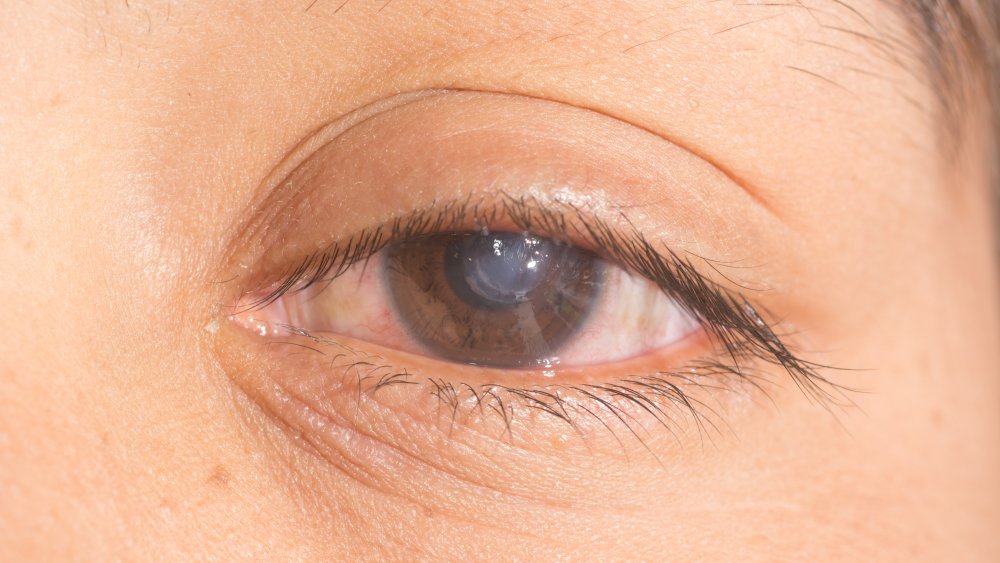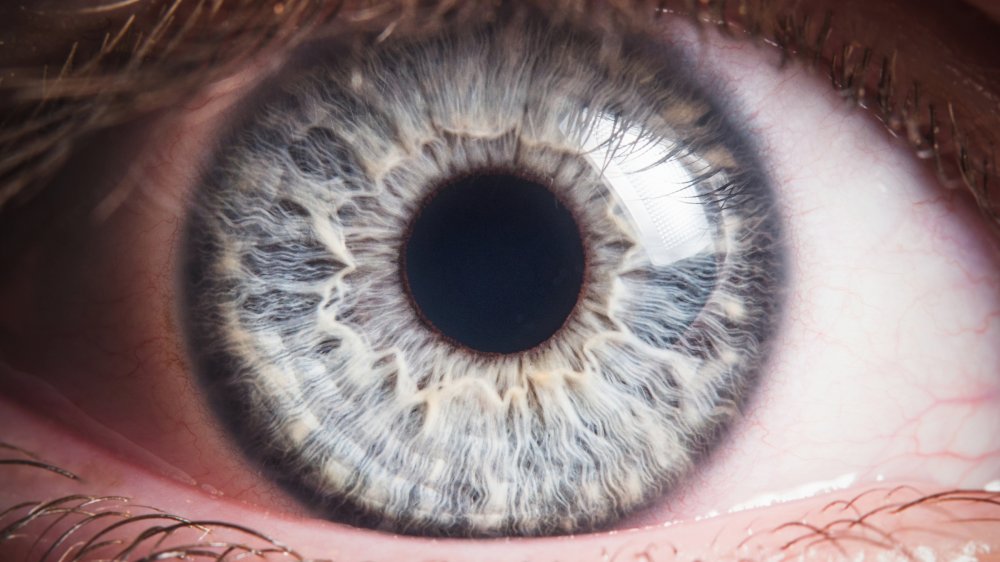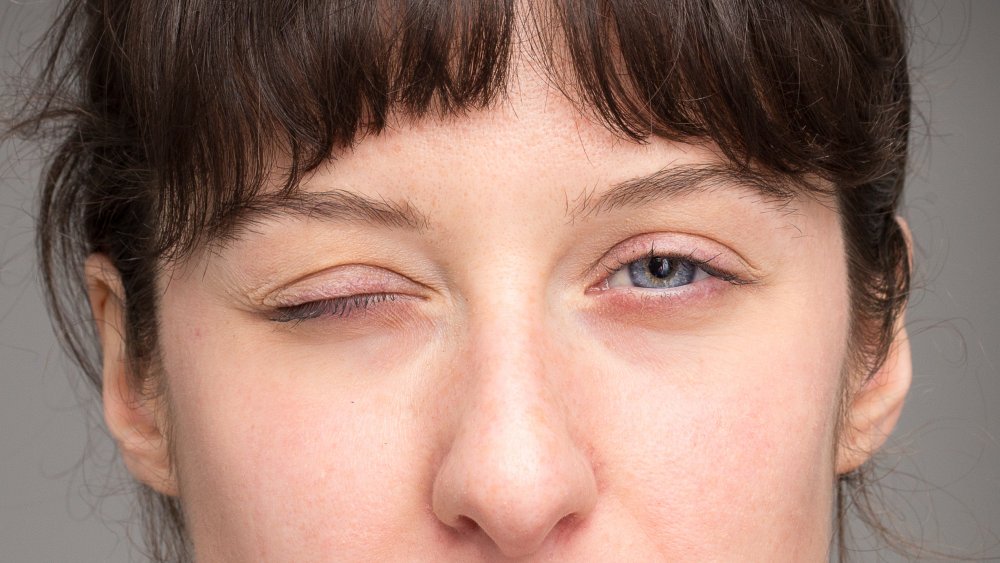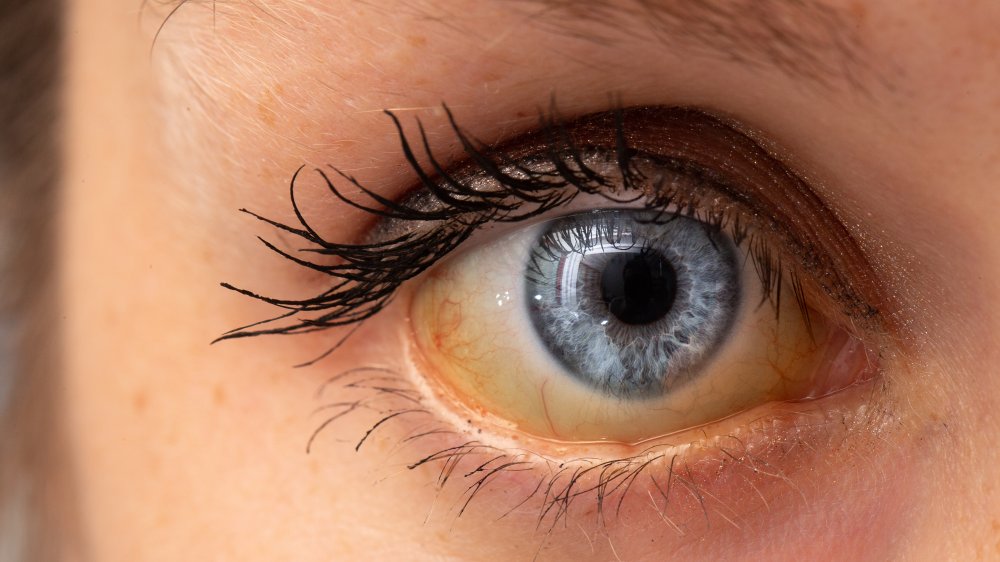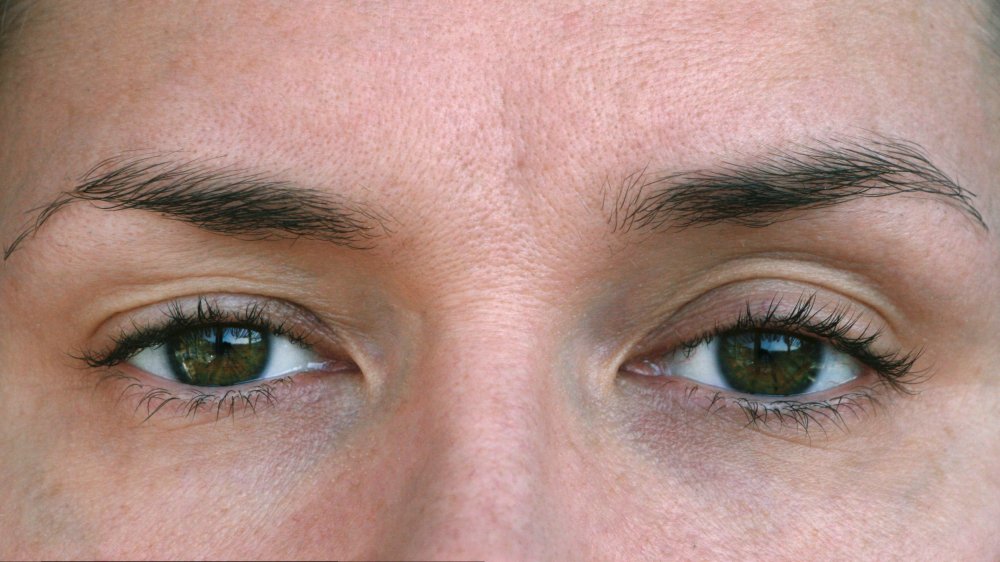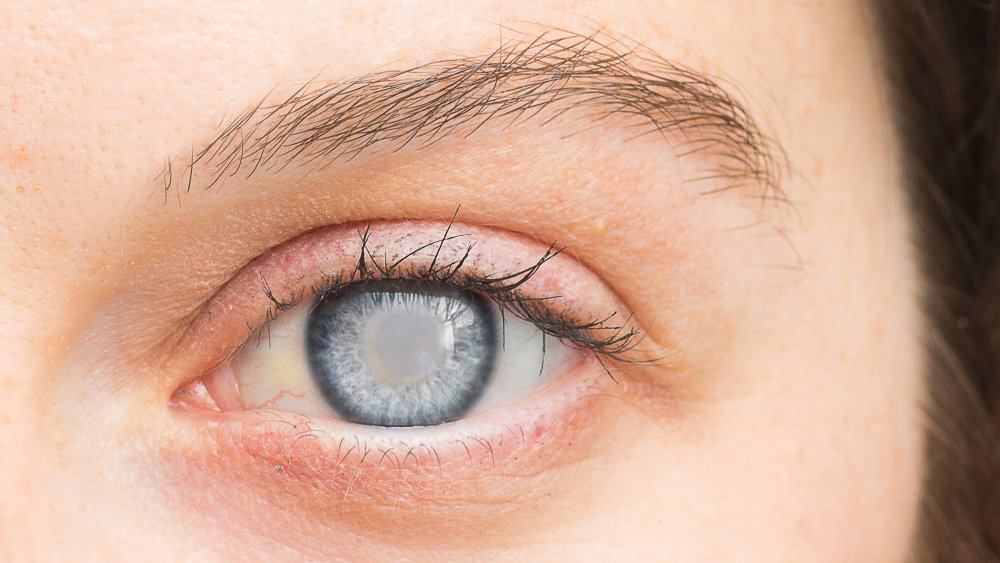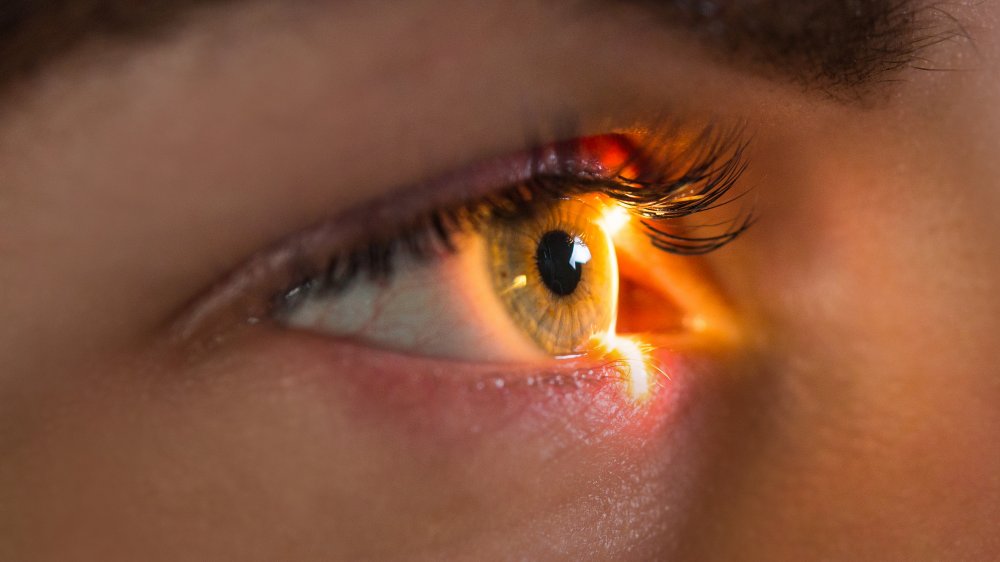The Surprising Things Your Eyes Reveal About Your Health
You may already know the basic things your eyes can reveal about your health. Red, puffy eyes can mean you've been crying, dark circles under your eyes can point to how little sleep you've been getting, and bloodshot eyes mean you've been logging too many hours in front of the computer. But that's just the tip of the iceberg when it comes to the incredible secrets your peepers can reveal about your health.
Dianna L. Seldomridge, ophthalmologist and clinical spokesperson for the American Academy of Ophthalmology, told Health Digest, "From blood flow to the functioning of your immune system, the health of your eye is directly related to the health of the body." Seldomridge continued, saying, "And since we can examine each component at a microscopic level right in an office setting without having to perform any invasive procedures, looking at your can be an incredibly useful tool for examining a patient's overall health."
Whether you've gone in to the eye doctor for a proper eye exam, or you're doing a DIY test at home, here are some of the vital things you should check your own eyes for — plus a rundown of what symptoms you may spot could mean.
Sudden blurred vision can be a warning sign of diabetes or high blood pressure
Although not visible to the naked eye, high blood pressure can damage tiny blood vessels lining the eyes, leading to a sudden change in vision. Excess glucose or sugar in the blood can promote swelling in the eye and can also damage blood vessels within the retina, causing fluids to leak into the organ and significantly impair vision.
"One of the first things we teach medical students is that the eye is the window into the rest of the body," Dianna L. Seldomridge, ophthalmologist and clinical spokesperson for the American Academy of Ophthalmology, told Health Digest. "From a vascular standpoint, during a standard eye exam, we can easily detect high blood pressure and blocked veins in the eye. We also frequently see manifestations of diabetes, especially in people who don't have their diabetes well controlled."
Once vision loss from either condition is detected, physicians can help prevent further vision loss through a procedure called laser photocoagulation, in which they use a laser to seal or repair leaking blood vessels in the eye.
Tiny red or white spots could be a sign of a cornea infection
If you're studying your eyes in the bathroom mirror and notice tiny red or white flecks or spots in its clear outer coating of one of your eyes, you may have detected a potential cornea infection.
Think of your cornea as the clear glass window that allows light into your eye. Cornea infections — which medical experts also sometimes call keratitis or corneal ulcers — are tiny open sores that can form in the eye's outer protective layer. These sores can be caused by a number of different factors: stress, contact lens usage, injury, fungi, or even viruses. Although these infections are often painless, they can trigger itchiness in the eye, excess tearing, a stinging or burning sensation, or sensitivity to light.
According to the Mayo Clinic, you should consult an eye doctor as soon as possible if you believe you could have a cornea infection. Treatment for the condition usually includes some form of medication or medicated eye drop. Left untreated, a possible infection could progress quickly, leading to permanent scarring or blindness.
A twitching eyelid could be the result of stress or an early indicator of this disease
We've all experienced a bout of twitching eyelids. In most cases, it's painless and more of an annoyance than anything else. According to experts, twitching eyelids are often the result of stress, lack of sleep, or some form of substance abuse.
However, a twitching eyelid can also be a warning sign of something more severe: multiple sclerosis. Multiple sclerosis (MS) is an autoimmune disease that impacts the central nervous system including the brain, spinal cord, and optic nerves. The disease occurs when the body's immune system misfires, and that can cause damage to a substance called myelin that surrounds and protects nerve fibers. When the optic nerves that control movement of your eyelids are damaged or become inflamed, a condition called optic neuritis can develop.
Optic neuritis is often one of the first signs of MS; about half of people with MS will develop optic neuritis at least once in their lifetime, according to WebMD. This eye condition often improves on its own, but a doctor may recommend intravenous or oral steroids to help speed up a patient's recovery.
Notice a distinct ring around your iris? It could be a sign of high cholesterol
Cholesterol is a waxy substance found in the blood. It's produced by our livers as well as being found in the foods we eat. Although it's vital for production of new cells, the Centers for Disease Control and Prevention warn that more than half of adult Americans have cholesterol levels that are too high.
"High cholesterol is one of the easiest things to pick up in an exam," said Justin Bazan, optometrist and medical adviser for The Vision Council, told CNN. "Not a day goes by in my office where we don't detect a buildup of cholesterol."
To spot it, take a close look at your iris (the colored region in the middle of your eye). Look for a white, gray, or blueish ring around its edge. This is known as arcus senilis — a buildup of lipids and cholesterol that collect within the eye. Although almost every adult will develop some level of arcus senilis as they age, it's most common in men and African-Americans, according to the American Academy of Ophthalmology. Fortunately, it causes no damage to your vision, so no treatment is necessary. You will, however, want to treat your high cholesterol.
Dry, itchy eyes could be allergies — or a symptom of this autoimmune disease
For the nearly 50 million Americans with allergies, red, itchy eyes are a common, painful fact of life. Whether you're sensitive to dander, dust, pollen, or smoke, your eyes produce a substance called histamine, which causes them to redden and swell, becoming teary, itchy, and swollen. But those same symptoms can occur in people experiencing a much more serious condition: rheumatoid arthritis.
Rheumatoid arthritis (RA) is a chronic condition affecting 1.3 million Americans, according to Healthline. RA occurs when the immune system misfires and begins to attack tissue in the joints, especially collagen.
"The eye is like a microcosm of the entire body within a small little ball," Dr. Sunir J. Garg told the Arthritis Foundation. The retina physician and surgeon at Wills Eye Hospital in Philadelphia, Pennsylvania explained that since the sclera (the white of the eye) as well as the cornea are both made up almost entirely of collagen, RA can attack them as well. The resulting inflammation often triggers symptoms similar to allergen exposure.
Black floaters in your field of vision can be cause for alarm
Black specks, strings, rings, cobwebs — or whatever you call those floaters that sometimes dart around your field of vision — are usually not cause for alarm. Here's why: The eye is filled with jelly-like fluid. From time to time, tiny strands of this material can clump together, casting a shadow on your retina and creating the appearance of a floating object. A 2013 study published in the International Journal of Ophthalmology reported that 76 percent or people report seeing floaters regularly.
However, when a very large floater or a larger than normal number of floaters suddenly appear, it can be a sign of a retinal tear or detachment, according to the Mayo Clinic. When the retina tears, a tiny hole forms that allows fluid to collect underneath the retina, pulling it away from the rest of the eye and impairing vision.
Similarly, the retina can also become detached through aging or through the formation of scar tissue that again pulls it away from the rest of the eye. In both cases, if caught and treated early, physicians are generally able to correct the problem and restore vision.
Have a yellow patch or bump on the white of your eye? It could be surfer's eye
Pterygium? Sounds scary already, right? The good news is that this pink or yellow patch or bump on the white of the eye is actually one of the more benign conditions you can develop. It even goes by a catchy, less threatening name: surfer's eye.
You don't have to hit the wave to experience surfer's eye, though. Anyone who spends a lot of time in the sun can develop the condition. Surfers, however, face the greatest risk because they are exposed to sunlight in two ways: direct sunlight and reflected sunlight. Rays of sunshine bounce off the ocean and reflect back into their eyes, doubling their exposure to harmful UV radiation.
While its appearance can be worrying, these bumps on the white of the eye are more like a callus than a tumor. Usually located on the inside white of the eye, closer to the nose, pterygia (the plural term for the growths) usually have few symptoms and don't require treatment, the American Academy of Ophthalmology explained. Limiting sun exposure and wearing sunglasses when outdoors are the best ways to reduce your risk for developing the disorder.
These eye conditions are a sign of Lyme disease
According to the Centers for Disease Control and Prevention, nearly 300,000 people in the U.S. develop Lyme disease each year. Caused by bacteria that spread into the body through the bite of a deer tick, Lyme disease can be a chronic condition. Symptoms can include a small rash at the site of the bite. dizziness, joint pain that comes and goes, and fatigue, which can persist for months or even years.
Some people may also experience a non-contagious form of conjunctivitis (aka "pink eye") soon after contacting the disease, the University of Illinois College of Medicine explained. Eye inflammation may also occur in later stages of Lyme disease. Additionally, approximately five percent of patients with Lyme disease develop sudden facial weakness in which one or both sides of the face droop, Nate Jowett, a facial plastic and reconstructive surgeon, explained in an article for Massachusetts Eye and Ear. This usually happens a week to three weeks after "tick exposure."
Once treated, facial function can return within a few weeks, according to Jewett. While full recovery is possible, some individuals may develop permanent tightness in the face or experience involuntary facial movements such as closure of the eye — long-term side effects that may require surgery.
Yellowing of the whites of your eyes is a sign of jaundice
If the whites of your eyes are starting to look faded or discolored, it's time to see a specialist. Yellowing eyes is most often a sign of jaundice, according to Healthline, and jaundice one of the primary warning signs for both hepatitis and liver damage/disease. In both instances, the discoloration is often the result of problems with your liver.
A quick, basic anatomy lesson: You have a small number of red blood cells within your system that die and are replaced by new cells each day. A healthy, functioning liver filters those dead cells from your bloodstream. However, when you have hepatitis or liver disease, those dead cells can collect in the blood, promoting the formation of compounds that can darken the color of your urine, cause extreme itchiness in your skin, and yellow both your skin as well as the whites of your eyes (via Healthline).
According to the Cleveland Clinic, people with jaundice may also experience fever, chills, and stomach pain, but the condition is not usually treated. Liver disease, however, is treatable and can sometimes be lessened with simple lifestyle modifications or prescription medications. And as your liver health improves, the yellowing will dissipate.
Bulging eyes might be the result of thyroid eye disease
When your eyes appear to pop, people generally think you're experiencing a severe bout of emotions — anger or rage so severe you're about to blow your top. But bulging eyes can also be caused by a rare condition called thyroid eye disease (TED). According to researchers at Swansea University in the U.K., symptoms include bulging eyes, pulled-back eyelids, double vision, all-over tenderness in the eyes, and a dry or gritty feeling in the eye.
TED is often associated with another condition called Graves' disease. While related, the two conditions are different; TED impacts the eyes while Graves' disease attacks the thyroid. However, the trigger behind the disorders is the same: The immune system causes inflammation and swelling of the impacted organ. As TED worsens, the eyeball is often pushed further and further forward in its socket, causing the bulging appearance.
Loss of vision from the disease is rare, according to the University of Michigan Kellogg Eye Center. Treatment typically consists of a corticosteroid to suppress the autoimmune inflammation plus therapies to help keep the eyes moist and reduce swelling.
This is what a drooping eyelid may mean
If you notice one of your eyelids appears droopy or is hanging down and partially impairing your vision, you're likely experiencing something called ptosis. The condition has numerous causes; it could be something you were born with, caused by swelling in the eyelid due to a stye, or even just a normal part of aging. But ptosis can be caused by other illnesses as well.
One of the more rare causes is an autoimmune disease called myasthenia gravis, which occurs in roughly 14 to 20 out of every 100,000 people, according to Healthline. Myasthenia gravis can weaken muscles throughout the body, but it most often attacks — and first shows up within — the muscles that control the movement of the eye.
Symptoms include drooping of one or both eyelids, blurred or double vision, difficulty swallowing and shortness of breath, according to the National Institute of Neurological Disorders and Stroke. Since the condition is rare, a positive diagnosis takes time and may require a variety of blood tests and diagnostic procedures including a CT scan or an MRI.
Worsening night vision may be a sign of cataracts
Does the dark seem even darker to you now then it did when you were a kid? Headlights glare just a bit more when an oncoming car approaches? It may not be your imagination. Night blindness can be a sign of a vitamin A deficiency, but it could be a result of a cataract in one or both of your eyes.
Cataracts block the flow of light into the eye, which may make you feel like you're looking through a foggy window. Proteins in the lens of the eye begin to break down as we age, which can create a thick, cloudy layer of tissue over the lens that impairs vision. This condition is common and widespread; the National Eye Institute estimates that by 2050, the number of people in the U.S. with cataracts is expected to double from about 24 million to about 50 million.
The standard treatment for cataracts is cataract replacement surgery. During this procedure, the affected lens is surgically removed from the eye and replaced with an artificial lens. More than 3 million people in the U.S. undergo cataract surgery each year.
Itchy, flaky eyelids can point to psoriasis
More than 8 million people in the U.S. develop psoriasis, a painful skin condition, each year, according to the National Psoriasis Foundation. About 10 percent of people with the condition experience psoriasis of the eyelid, Medical News Today explained.
Psoriasis occurs when the immune system speeds up skin cell growth. Normal skin cells completely grow and fall off approximately once a month. With psoriasis, skin cells grow much faster — completing their growth cycle in just three or four days. And instead of falling off, the cells simply pile up on top of each other, causing painful itching, burning, and stinging sensations.
When this happens on the eyelid, a person can experience crustiness around the eyelid, pain when moving the eye, and scales that resemble dandruff flaking off and sticking to the eyelashes. As with psoriasis in other areas, eyelid psoriasis is typically treated with topical or oral medications. In an interview with the journal EyeWorld, Inna Ozerov, an ophthalmologist based in Florida, pointed out other symptoms for patients with psoriasis to look for including blurred vision, pain, redness, and light sensitivity.
That dark spot in the corner of your eye could be a melanoma
From lymphomas to sarcomas to carcinomas, there are dozens of types of cancers that can develop in and around the eye. Luckily, a good eye doctor is on the lookout for all of these when they perform a standard eye exam.
"When you go to an ophthalmologist, we really look at every level of the eye," Dianna L. Seldomridge, ophthalmologist and clinical spokesperson for the American Academy of Ophthalmology, told Health Digest. "Starting with the tissue surrounding the eye, we can spot different types of skin cancers including basal cells, squamous cell carcinomas, and melanoma. Moving in, we check the health of the cornea and iris and look for the different types of cancers that can occur there."
Seldomridge went on to explain that the retina and optic nerves are also checked. Signs of brain tumors can sometimes even be seen during an exam. To spot potential problems early, the doctor recommends getting a baseline exam of your eyes upon turning 40, and regular follow-ups thereafter.



